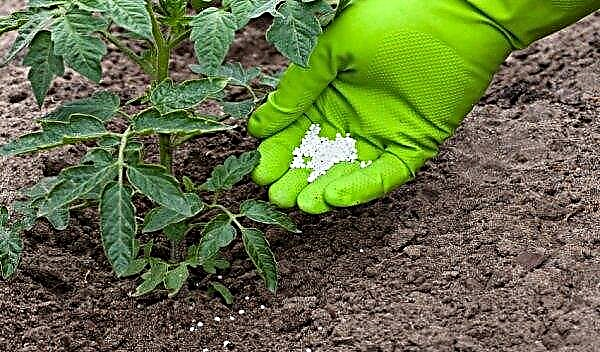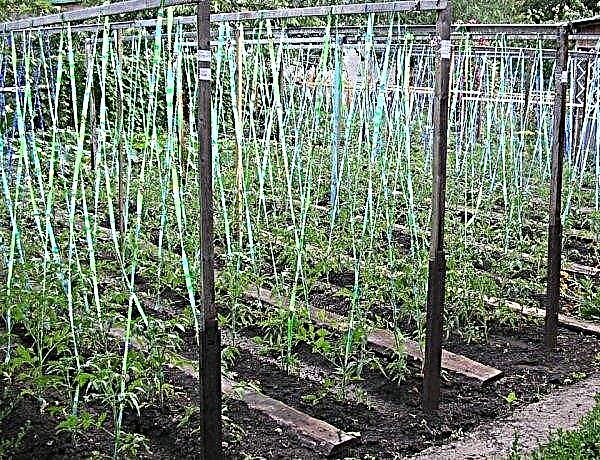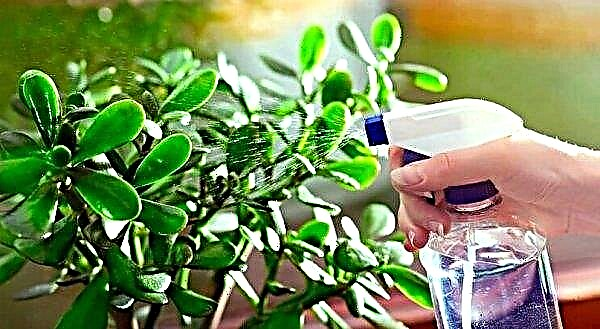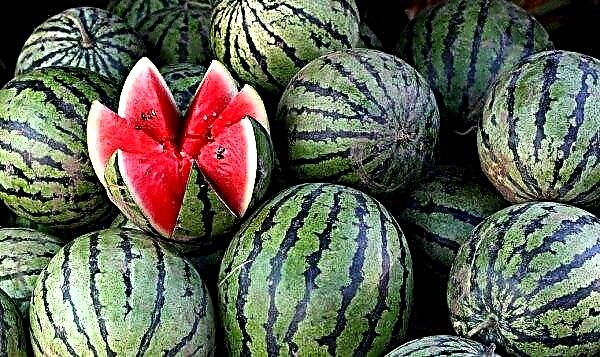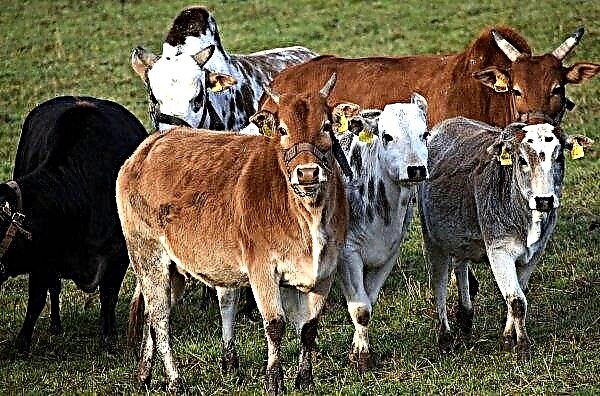Japanese cabbage is no less useful plant than exotic, so every year it occupies an increasing number of suburban areas. The culture is not like the traditional varieties of cabbage, so it has something to surprise even sophisticated gardeners and lovers of rare flora. The article discusses in detail the main features of Japanese cabbage and the subtleties of its cultivation.
The origin and description of the culture
This fruit plant has been known for a long time. Despite the name, the homeland of this cabbage is considered the ocean coast of China. In this area, culture has been actively grown and used for food for centuries. In Japan, the species first appeared in the XVI century, after which it became popular among the country's population, due to its unpretentiousness and productivity.
Did you know? Cabbage contains substances that can prevent the development of cancer. Daily use of a vegetable is one of the most effective cancer prevention measures.
In Europe, the plant began to be actively grown at the beginning of the XX century, from this moment its famous name arose. It is an annual herbaceous plant, about 60 cm high. It is distinguished by a shortened stem-rosette, from which numerous leaves are formed. They are smooth or corrugated, the sheet plate is strongly dissected, saturated light green in color. However, hybrids are also found with brighter, reddish-brown foliage.
The leaves are often large, about 60 cm long, form a lush spreading bush up to 90 cm wide. Unlike related species, the plant does not head out, so the leaves become a crop. Productivity is high - up to 7–10 kg / m². Only green mass is used for food, which is ready for collection already 30–35 days after sowing.
Is it possible to plant Japanese cabbage at home?
Often the plant is called "cabbage for the lazy." This means that the species is unpretentious to living conditions and microclimate, therefore, together with traditional types of greenery, it can be successfully grown even in a garden pot. However, in order for the crop on the windowsill to be not only rich, but also fragrant, the greens will have to create good lighting.
Properties of Japanese Cabbage
The plant has proven itself. They can successfully supplement the diet, as well as decorate the site, since the leaves of cabbage are particularly decorative. However, in addition to this, the species is also famous for its many useful substances that safely affect the human body.
Benefit
- Japanese cabbage is valuable to humans, thanks to:
- increased concentration of vitamins A, E, as well as ferum, selenium, calcium, potassium and phosphorus;
- ability to improve the cardiovascular system;
- accumulation of beta-carotene in the tissues, which is important for maintaining the optimal functioning of the organs of vision;
- low calorie content;
- excellent taste and aromatic properties;
- long vegetation period, which contributes to productivity throughout the summer.
Harm
- There are not many shortcomings in this fruit crop, but they are, they include:
- short storage period - kale remains fresh for several days after harvest;
- during storage, the leaves lose aromatic qualities;
- with an intensive growing system, the crop accumulates nitrates.
Optimal landing times
Japanese cabbage is unpretentious and frost-resistant plant, so you can grow it throughout the frost-free season. Most often, vegetable crops are carried out from late April to the second half of July. Experienced gardeners sow the crop twice a season, in early spring and mid-summer. In a temperate climate, this makes it possible to get a quality crop from the second half of May to the end of October.
Important! The dude is not suitable for heat treatment, it is used as a component of fresh salads or used to decorate fish and meat dishes. This must be considered when choosing a variety for sowing.
The best varieties of Japanese cabbage
Today, many varieties of Japanese cabbage are known. Only a few have gained particular popularity, since the majority are distinguished by their whimsicality to heat and moisture, as well as low productivity. In this regard, the following varieties can often be found on the beds:
- Emerald pattern - an early ripe, slightly raised type of cabbage, up to 35 cm long and about 60 cm in diameter. The highlight of the variety is the increased number of leaves in the rosette, on average there are about 150 pieces per plant. The leaves are smooth, have large incisions around the edge, saturated green. The taste of the leaves is delicate, with a slight apple tint. Productivity of a grade does not exceed 5 kg / m².

- the little Mermaid - a mid-season variety, it is characterized by a height of about 45 cm and a diameter of the rosette up to 75 cm. The leaves are often smooth, strongly dissected, green in color. The taste of the leaves is delicate, with a slight mustard aroma. The yield of the plant is 5-6 kg / m².

- Mizuna - cabbage with an average ripening period, its height is not more than 40 cm, and its diameter is up to 70 cm. The leaves are large, have large cuts around the edge. Two hybrid varieties are known, the so-called green and red. The first is rich in emerald color of leaves, the second is covered with green-red foliage. The color of the leaves is delicate and exquisite. Productivity of Mizuna is up to 7 kg / m².

- Dude - ultra-early hybrid, capable of giving up to 6 crops per season. The height of the bush often does not exceed 40 cm, width - 65 cm. The leaves are saturated green, strongly dissected. The taste of the leaves is gentle and moderate. Productivity reaches 6 kg / m².
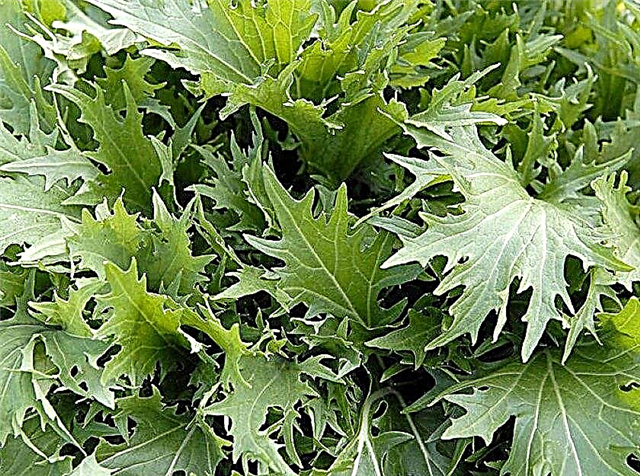
Growing methods
Like any fruit crop, Japanese cabbage is grown through seedlings, as well as direct sowing in the soil. Despite the fact that both methods are widely and actively used by modern vegetable growers, their effectiveness is different.
Seedling method
Seeds are sown for seedlings often in late April. Sowing is carried out in individual glasses, this cabbage is difficult to transplant, so after germination it should dive once. Seeds are often sown to a depth of 1-2 cm. At least 2-3 seeds are placed in each well, after germination of which one, the most viable sprout is left. This will help to avoid low germination and irrational use of containers.
Important! Before sowing the seeds must be sterilized. To do this, they are soaked for 20-30 minutes in a 1-2% solution of potassium permanganate or for 5-10 minutes in 70% alcohol.
For sowing, use any loose and fertile soil for cultivated plants. You can cook it yourself, for this a mixture of peat, turf land and river sand is suitable (2: 1: 1). Sown containers are germinated in a warm, well-lit place at a temperature of +15 ... + 22 ° C. Flowerpots are watered sparingly, at least 1-2 times a week.
About 30 days after sowing, the cabbage is transplanted to a permanent place. A transplant is carried out by transshipment, for this, the soil together with the plant is carefully removed from the pot and placed in a permanent place. In this case, the beds are arranged in a row-wise way, with a row spacing of 30 cm and a distance between adjacent bushes within 15–20 cm.
Reckless method
A seedless method is preferred when growing Japanese cabbage. In addition to the fact that it is not inferior to seedlings in efficiency, in this case it is possible to avoid negative effects on young plants. The root system of the species is tender, so cabbage hardly tolerates a pick. Often this technique is used both for growing cabbage in open soil or a greenhouse, and for cultivating a vegetable on a windowsill, in an individual pot.
Important! In order to accelerate seed germination, the beds are tightly covered with a transparent plastic film. It causes a local greenhouse effect, which activates the process better (after emergence, the shelter is removed).
Japanese cabbage is sown in any fertile soil in a row-like manner, with a row spacing of about 30 cm and a distance between bushes in a row of about 20 cm. The site should be in a well-lit place, away from tall vegetation. In the case of planting on the windowsill, large pots with a diameter of about 15 cm are used for this, in which the seeds are sown in a fossilized manner. In this case, no more than 1 plant should fall on one tank. Cabbage is sown to a depth of 0.5-1 cm, after which the crops are well moistened with warm water (+20 ... + 25 ° C).
Features of caring for Japanese cabbage
Proper care is important to get a rich crop. Only with its help it is possible to achieve active growth and increase in above-ground mass, which directly affects the productivity of plants. To do this, plantings need to create a special microclimate, including providing timely watering and top dressing.
Watering and feeding
The beds are watered sparingly as soon as a distinct, dry crust appears on the soil. Young bushes are moistened 2-3 times a week and only with a spray. This is necessary in order to avoid damage, after the bush has grown, the beds are moistened in any convenient way. Adult plants are intensively watered only in the heat, in other cases, the procedure is carried out no more than 1-2 times a week.
Water is thoroughly added to the beds, it must completely soak the soil, up to the lower layers, so at least 10-15 liters of liquid are added per 1 m². They feed cabbage no more than 2 times per season. This is done for the first time 2-3 weeks after germination, and then after harvesting 1-2 generation of leaves.
Important! When growing this culture, insecticides are prohibited, since the leaves are able to accumulate derivative drugs harmful to humans.
Complex mixtures based on phosphorus and potassium are used for this. You can replace them with a solution of vermicompost or infusion of wood ash (in 1 liter of water for 5-7 days, insist 3 tablespoons of crushed ash).
Loosening and weeding the soil
Loosening and weeding are often combined, this saves labor costs for cultivating crops, as well as avoiding excessive stresses for planting. Perform the procedure no more than 1 time per week, after heavy watering. This makes it possible to avoid the appearance of weeds, and also saturates the soil with the necessary amount of oxygen. The substrate is loosened to a depth of 7-10 cm, already 2-3 weeks after the appearance of the first shoots, and then throughout the entire vegetative period.
Pest and Disease Control
The main problem of Japanese cabbage are pests that willingly infect foliage. As a result, their market value, as well as quality, decreases, and in the advanced case, pests lead to the death of bushes. To combat the problem use tobacco dust, which is dusted with foliage and the trunk circle, and also added to water for irrigation (in a ratio of 1:10).
You can replace tobacco dust with an ash solution (3 tablespoons per 1 liter of water), which thoroughly spray bushes and row spacings. In addition, plantations are affected by leaf rot. The cause of the pathology is the waterlogging of the substrate, so often watering regulation makes it possible to recover bushes without active antifungal drugs.
Did you know? Sour cabbage was invented in Ancient China, but at that time, to achieve the desired culinary effect, the vegetable was soaked in wine.
To prevent the development of culture-specific diseases and infections will help:
- crop rotation on the site - cruciferous plants at the same place should grow only every 3-4 years;
- thorough preparation of the soil before sowing;
- avoidance of thickening of crops;
- seed disinfection;
- proper watering and care of the beds.
Harvesting and storage methods
Depending on the variety, the first crop of cabbage is harvested 30–40 days after the appearance of the first seedlings. Young leaves are considered the most valuable, therefore, when they reach a length of 10-15 cm, they collect greenery. After 1-2 weeks, the place of slices will be restored, after which you can again collect cabbage. For harvesting use only a sharp kitchen or special garden knife. Young leaves are not fresh stored for long. Often the leaves remain edible for a week after collection. However, for this they need to create special conditions: humidity of at least 90% and a temperature of 0 ... + 5 ° C. To achieve this, cabbage is stored in the refrigerator, wrapped with cling film or plastic bag. Otherwise, the greens will fade within 1–2 days.
Young leaves are not fresh stored for long. Often the leaves remain edible for a week after collection. However, for this they need to create special conditions: humidity of at least 90% and a temperature of 0 ... + 5 ° C. To achieve this, cabbage is stored in the refrigerator, wrapped with cling film or plastic bag. Otherwise, the greens will fade within 1–2 days.
Ways to consume cabbage
Most often, Japanese cabbage is consumed fresh. Seasonal salads are prepared from it or a vegetable is used as a spice to give zest to cold dishes. Also, greens are often used as an additional ingredient to recipes, including in the preparation of meat, fish dishes and vegetable stews.
In this case, the delicate mustard aroma of cabbage becomes one of the main spicy aftertaste. The most famous dish from this vegetable is Nabemono salad, it is used as a traditional festive Japanese food, which is served in combination with both alcoholic and non-alcoholic drinks.
Despite its exotic origin, Japanese cabbage is an unpretentious plant that can be grown even on the windowsill. This fruit species has become valuable for cooking due to its special aroma and exquisite taste, which can complement any dish. However, in order to achieve this, cabbage should be provided with appropriate care and microclimate.








